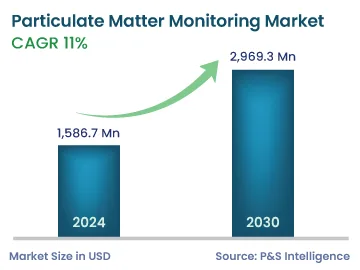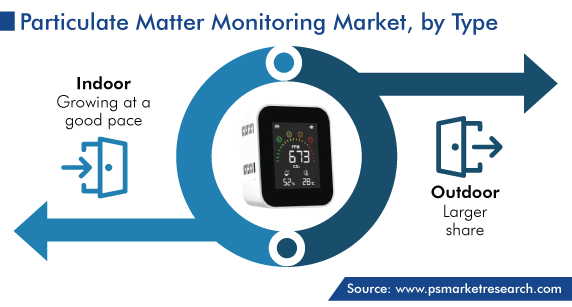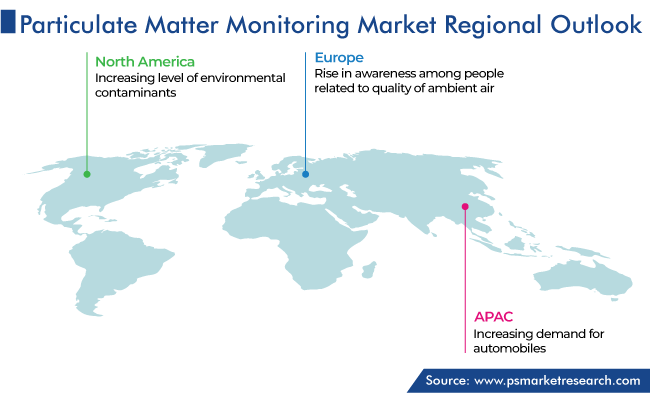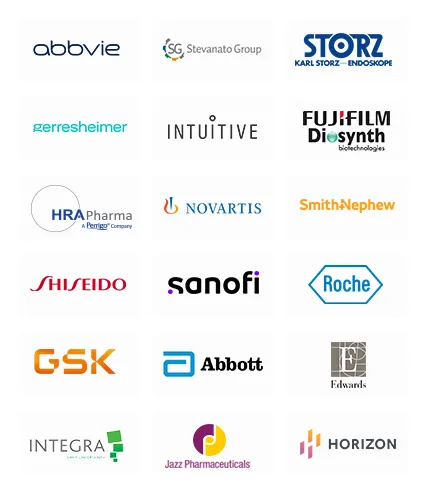Market Statistics
| Study Period | 2019 - 2030 |
| 2024 Market Size | 1,586.7 Million |
| 2030 Forecast | 2, 969.3 Million |
| Growth Rate(CAGR) | 11% |
| Largest Region | North America |
| Fastest Growing Region | Asia-Pacific |
| Nature of the Market | Consolidated |
Report Code: 12812
Get a Comprehensive Overview of the Particulate Matter Monitoring Market Report Prepared by P&S Intelligence, Segmented by Particle Size (PM1, PM2.5, PM4, PM10), Type (Indoor, Outdoor), Technology (Light Scattering, Beta Attenuation, Gravimetric, Opacity), Application (Power Generation, Oil & Gas, Chemical & Petrochemical, Healthcare), and Geographic Regions. This Report Provides Insights From 2019 to 2030.
| Study Period | 2019 - 2030 |
| 2024 Market Size | 1,586.7 Million |
| 2030 Forecast | 2, 969.3 Million |
| Growth Rate(CAGR) | 11% |
| Largest Region | North America |
| Fastest Growing Region | Asia-Pacific |
| Nature of the Market | Consolidated |

Explore the market potential with our data-driven report
The particulate matter monitoring market size stands at an estimated USD 1586.7 million in 2024, and it is expected to advance at a compound annual growth rate of 11.0% during 2024–2030, to reach USD 2,969.3 million by 2030.
The growth can be primarily ascribed to the increasing air pollution and growing awareness among people regarding the advantages of healthy air quality. Moreover, the stringent government regulations to reduce emissions in view of the rapid industrialization and urbanization are expected to propel the market.
Further, the advancements in the technology used for monitoring the level of particulate matter will continue driving this growth over the coming years. Contemporary PM monitoring systems provide real-time measurements of the air quality, which helps in forecasting the changes in it across several locations, including industrial sites and major city areas. PM impacts the health negatively, especially the throat and nose, as it enters the body from here, and then, reaches the lungs. These particles are minute in size, because of which they deposit on the surface of the lungs, causing tissue damage and lung inflammation.
Across the globe, the quality of the air decides the rate at which the climate degrades. Air pollution majorly happens due to the emission of greenhouse gases during the burning of fossil fuels. Therefore, several long- and short-term emission mitigation policies have been implemented for lowering the pollution in the environment and enhancing the health of people. Across the globe, the level of particulate matter is intensively monitored for providing data on the quality of the air to local, state, and federal regulatory bodies. This is done both to ensure people breathe clean air and to hold industries and entities accountable for not adhering to national emission and air quality standards.
In most countries, the increasing industrialization rate is one of the major factors contributing toward the rise of the market revenue. Since industrialization is only possible with the availability of an adequate labor force, as it happens, a large number of people arrive in cities from rural areas. Inventions, cheap labor, advancing technology, and easy availability of raw materials continue to shape urbanization trends in emerging economies. This has further improved the economic growth prospects and overall industrial production around the world. Moreover, with urbanization and industrialization, the number of automobiles on the roads has risen, which continues to fuel the demand for PM monitoring systems.
The PM2.5 category is expected to witness a CAGR of 11.1%, because impurities of this size are a major concern as they make the air unhealthy. It can lead to various health issues, such as asthma, low birth weight, and heart diseases. Moreover, they minimize visibility, because of which everything in cities such as Beijing and Delhi often appear hazy. When this air enters the lungs, it irritates and erodes the alveolar wall. According to the American Cancer Society, around 238,340 new cases of lung cancer are to be diagnosed in 2023, out of which 117,550 will be men, and 120,790 will be women.
The growing prevalence of lung cancer boosts the demand for monitoring PM, as this particle is a key cause of this chronic disease. The increasing awareness among people regarding the monitoring of particulate matter levels aids in this growth.
On the basis of end use, power generation holds the largest share, of 30%. During the generation of electricity, large amounts of pollutants are emitted into the atmosphere. The waste generated from industrial sectors and municipalities, biomass, and fossil fuels, including coal, petroleum, and natural gas, are used for approximately 60% of the power generated worldwide. For reducing the pollution caused by thermal power plants, it is necessary to install such systems to monitor the levels of PM and other pollutants in the exhaust, before it is released into the air.
Similarly, in the oil and gas industry, considerable amounts of nitrogen oxide, sulfur dioxide, carbon monoxide, carbon dioxide, volatile organic compounds, hydrogen sulfide, and various other harmful agents are released. Sources of pollution here include tail gas units, process heaters, boilers, flares, fluidized catalytic cracking regenerators, equipment leaks, and storage facilities. Which particles are released and how much depend on the design of burners, efficiency of dust-catching equipment, the maintenance of equipment, type of fuel used, and concentration of oxygen. Hence, for the identification of such pollutants, the industry widely uses particulate matter monitors.
Outdoor monitoring holds the larger share, attributed to the increasing outdoor pollution because of the presence of a large number of industries and the rising transportation and construction activities.
As per the U.S. EPA, between 1970 and 2022, the emission of pollutants, such as PM10, SO2, NOx, VOCs, CO, Pb, and PM2.5, reduced by 78% due to the implementation of efficient monitoring techniques. In several sectors, the regulatory policies for air quality have helped in achieving these targets, aided by the deployment of monitoring systems even at the grassroot level.
Moreover, the European Union issued a legislative proposal in October 2022 for updating and combining two of its Ambient Air Quality Directives. According to the amendment, by 2030, the EU needs to set interim air quality criteria, and by 2050, the target is to reach the zero level. This initiative has been taken to improve the air quality, which will propel the demand for particulate matter monitoring equipment.
In addition, the Government of Bahrain and its public utilities and Environmental Affairs Committee has decided that pollution should be measured outside stores, malls, and residential compounds. Due to these measures, the market would continue to grow in this category in the forecast period.
The indoor monitoring category is also growing significantly because of the rising adoption of such systems and the increasing popularity of green buildings and smart homes. It has been evaluated that 75–85% of the people spend most of their time inside on a routine basis. Impurities present in the indoor atmosphere cause various types of allergies, respiratory disorders, and numerous other issues.
Here, indoor PM level tracking systems offer real-time monitoring capability using a limited sample volume of the air and options for digital and analog outputs. With people becoming more aware of their health and VOC emissions increasing from household solvents, the focus on indoor PM monitoring will continue to grow.

The light scattering technology holds the largest share, of 35%, ascribed to the strict environmental regulations and the improved precision with which particulate matter emissions can be monitored by it. The scattering of light has a larger magnitude, mostly at the forward angles of scattering, when compared to back scattering angles, along with the small size of angles and high mass sensitivity.
The usage of the beta attenuation technology is also growing rapidly as it is known for the absorption of beta radiation by solid particles extracted from the air. The technology helps in the detection of the levels of PM2.5 and PM10, which most of the regulatory agencies around the world monitor.
North America has the leading position in the particulate matter monitoring market, and it will hold the same position in 2030, accounting for a value of USD 1.4 billion. The growth is ascribed to the increasing level of environmental contaminants and the stringent regulations to tackle this issue.
In North America, the U.S. holds the leading position, and it will grow at a CAGR of 11.3% during the forecast period. This is attributed to the presence of key players and individuals’ rising awareness regarding safe air. Additionally, the growing pace of technological advancements in these systems is contributing toward revenue generation.
Moreover, the country has various stringent government regulations for controlling the ill effects of power generation and transportation on the environment. Among these, the U.S. Environmental Protection Agency’s Clean Air Act and Acid Rain Program are noteworthy. Across the nation, the concentration of particulate matter is monitored, and the data is used by municipal agencies, the EPA, and state authorities to ensure that its levels in the air are safe for the environment, humans, and other species.

Further, the market in Europe is growing considerably due to a rise in the awareness among people related to the quality of ambient air. Additionally, industries, entities, and individuals in the region display strong compliance with the environmental regulations imposed by the government. The European air quality directives are aimed at preserving the health of plants, humans, and natural ecosystems.
Further, under the Zero Pollution Action Plan of the European Green Deal, the EU has targeted to lower the number of premature deaths brought on by PM2.5 by at least 55% by 2030 from the 2005 levels.
Based on Particle Size
Based on Type
Based on Technology
Based on Application
Geographical Analysis
The particulate matter monitoring industry CAGR is 11.0%.
Power generation is the key end use in the market for particulate matter monitoring solutions.
The strongest particulate matter monitoring industry drivers include the rising air pollution levels and rapid urbanization and industrialization.
The light scattering technology holds the largest share in the market for particulate matter monitoring solutions.
The key countries in the particulate matter monitoring industry include the U.S., the U.K., Germany, India, Japan, South Korea, and China.
Outdoor monitoring generates the higher revenue in the market for particulate matter monitoring solutions.
Want a report tailored exactly to your business need?
Request CustomizationLeading companies across industries trust us to deliver data-driven insights and innovative solutions for their most critical decisions. From data-driven strategies to actionable insights, we empower the decision-makers who shape industries and define the future. From Fortune 500 companies to innovative startups, we are proud to partner with organisations that drive progress in their industries.


Working with P&S Intelligence and their team was an absolute pleasure – their awareness of timelines and commitment to value greatly contributed to our project's success. Eagerly anticipating future collaborations.
McKinsey & Company
IndiaOur insights into the minutest levels of the markets, including the latest trends and competitive landscape, give you all the answers you need to take your business to new heights
We take a cautious approach to protecting your personal and confidential information. Trust is the strongest bond that connects us and our clients, and trust we build by complying with all international and domestic data protection and privacy laws
Customize the Report to Align with Your Business Objectives
Request the Free Sample Pages